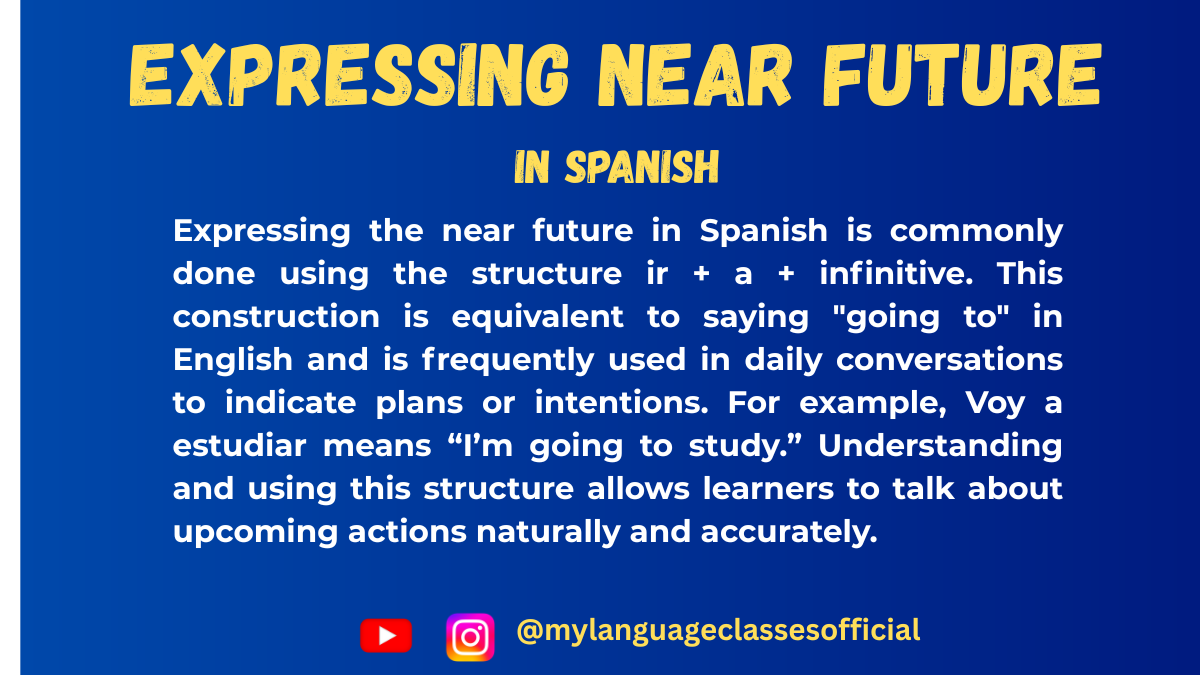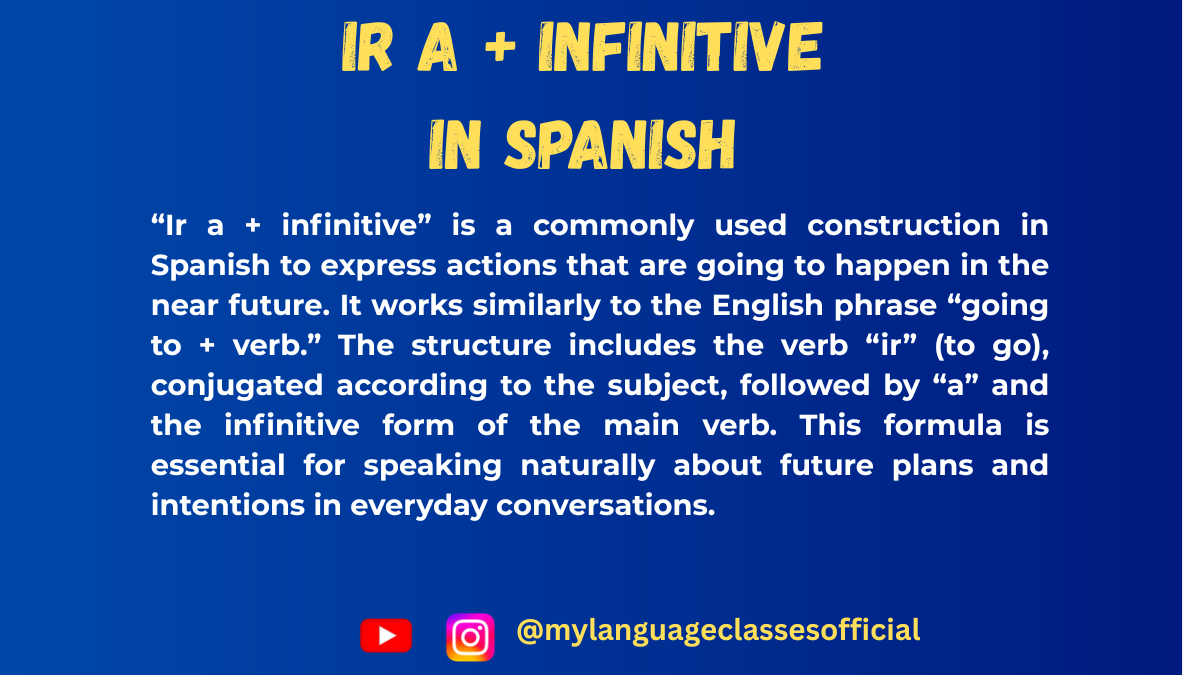Your cart is currently empty!
Tag: ir a + infinitive
-

Ir a + Infinitive: Expressing Near Future in Spanish
In Spanish, the construction “Ir a + infinitive” is commonly used to express actions that will happen in the near future. This is equivalent to the English “going to + verb” structure. It is widely used in spoken and written Spanish and is easier to learn compared to the simple future tense.
Formation of “Ir a + Infinitive”
The structure consists of three elements:
- The verb “ir” (to go) conjugated in the present tense.
- The preposition “a” (to).
- An infinitive verb (unconjugated verb).
Conjugation of “Ir” in Present Tense:
Subject Pronoun Conjugation of “Ir” Yo voy Tú vas Él/Ella/Usted va Nosotros/as vamos Vosotros/as vais Ellos/Ellas/Ustedes van Sentence Structure:
Subject + Ir (conjugated) + a + Infinitive Verb
Example Sentences:
- Voy a estudiar. (I am going to study.)
- Vamos a viajar a México. (We are going to travel to Mexico.)
- Ellos van a comprar una casa. (They are going to buy a house.)
Usage of “Ir a + Infinitive”
1. Near Future Actions
Used to express something that is about to happen soon.
- Voy a llamar a mi madre. (I am going to call my mother.)
- Ella va a cocinar la cena. (She is going to cook dinner.)
2. Intentions or Plans
Used when someone has planned to do something.
- Vamos a ver una película esta noche. (We are going to watch a movie tonight.)
- Voy a aprender español este año. (I am going to learn Spanish this year.)
3. Predictions Based on Evidence
Used when there is evidence that something is about to happen.
- Va a llover. (It is going to rain.)
- El bebé va a llorar. (The baby is going to cry.)
4. Giving Commands or Warnings
Used to give warnings or strong suggestions.
- Vas a romper el vaso. (You are going to break the glass.)
- Van a llegar tarde si no se apuran. (You all are going to be late if you don’t hurry.)
Articles, Gender, and Plural Considerations
When using “Ir a + Infinitive,” remember:
- Definite Articles (el, la, los, las) and Indefinite Articles (un, una, unos, unas) should match the noun in gender and number.
- Example: Voy a comprar una bicicleta. (I am going to buy a bicycle.)
- Example: Vamos a visitar el museo. (We are going to visit the museum.)
- Verb agreement: The conjugation of “ir” changes based on the subject.
- The infinitive verb does not change regardless of the subject.
Common Verbs Used with “Ir a + Infinitive”
Here is a list of common verbs and their “Ir a + Infinitive” forms:
Infinitive Verb Meaning “Ir a + Infinitive” Example Comer To eat Voy a comer pizza. (I am going to eat pizza.) Beber To drink Vas a beber agua. (You are going to drink water.) Estudiar To study Ella va a estudiar matemáticas. (She is going to study mathematics.) Viajar To travel Vamos a viajar a España. (We are going to travel to Spain.) Comprar To buy Van a comprar un coche. (They are going to buy a car.) Hacer To do/make Voy a hacer mi tarea. (I am going to do my homework.) Tener To have Vas a tener una sorpresa. (You are going to have a surprise.) Llegar To arrive Ella va a llegar temprano. (She is going to arrive early.) Jugar To play Vamos a jugar fútbol. (We are going to play soccer.) Dormir To sleep Van a dormir temprano. (They are going to sleep early.) Regular and Irregular Verbs in “Ir a + Infinitive”
All verbs, whether regular or irregular, remain in the infinitive form after “a.”
Regular Verbs (AR, ER, IR Verbs)
- Hablar (to speak): Voy a hablar con mi amigo. (I am going to speak with my friend.)
- Comer (to eat): Vamos a comer paella. (We are going to eat paella.)
- Vivir (to live): Ellos van a vivir en Barcelona. (They are going to live in Barcelona.)
Irregular Verbs
- Hacer (to do/make): Voy a hacer la tarea. (I am going to do the homework.)
- Tener (to have): Ella va a tener una fiesta. (She is going to have a party.)
- Poder (to be able to): Van a poder salir temprano. (They are going to be able to leave early.)
Conclusion
The “Ir a + Infinitive” structure is one of the most practical and commonly used ways to express the near future in Spanish. It is simple to form and widely understood in all Spanish-speaking regions. By practicing this structure with different verbs, you can quickly improve your Spanish fluency and express future plans with confidence.
Now that you understand how to use “Ir a + Infinitive”, start practicing by forming your own sentences!
If you enjoyed this lesson, be sure to check out more posts like this on my blog at My Language Classes. Don’t forget to subscribe my YouTube channel and follow me on Instagram for the latest language learning tips and lessons. Leave a comment below to share your thoughts, or ask any questions you have.
Happy learning! 😊
-

Near Future Tense in Spanish: Mastering Ir a + Infinitive
If you’re learning Spanish, you’ve likely encountered the phrase voy a estudiar (“I’m going to study”). This construction is an example of the near future tense, a simple and versatile way to talk about events that are going to happen soon. Today, we’ll explore how to use this tense, why it’s so practical, and how it compares to other future forms in Spanish. Let’s dive in!
What is the Near Future Tense?
The near future tense in Spanish uses the verb ir (to go), followed by the preposition a and an infinitive verb. It’s similar to the English construction “to be going to + verb.” For example:
- Voy a bailar. – I’m going to dance.
- Vamos a comer. – We’re going to eat.
- Ellos van a viajar. – They’re going to travel.
This structure is widely used in everyday conversation because it’s straightforward and easy to learn.
How to Form the Near Future Tense
The formula is simple:
[Conjugated form of ir] + a + [infinitive verb]Here’s how you conjugate ir in the present tense:
Subject Pronoun Conjugation of ir Yo voy Tú vas Él/Ella/Usted va Nosotros/as vamos Vosotros/as vais Ellos/Ellas/Ustedes van Once you’ve got ir conjugated, just add a and any infinitive verb:
- Voy a leer. – I’m going to read.
- ¿Vas a escribir? – Are you going to write?
- Ellos van a salir. – They are going to go out.
Why Use the Near Future Tense?
The ir a + infinitive construction is perfect for beginners because it’s less complicated than the simple future tense (hablaré, comerás, vivirán). It’s also highly practical—it allows you to talk about immediate plans or intentions without needing to learn additional verb conjugations.
For example:
- Instead of saying Estudiaré mañana (I will study tomorrow), you can say Voy a estudiar mañana (I’m going to study tomorrow).
- Both are correct, but voy a estudiar feels more conversational and is commonly used in informal settings.
Examples of Near Future in Everyday Situations
- Making Plans
- ¿Qué vas a hacer esta tarde? – What are you going to do this afternoon?
- Voy a ir al cine. – I’m going to go to the movies.
- Expressing Intentions
- Vamos a aprender mucho hoy. – We’re going to learn a lot today.
- Voy a ayudar a mi mamá. – I’m going to help my mom.
- Asking Questions
- ¿Vas a venir a la fiesta? – Are you going to come to the party?
- ¿Van a preparar la cena? – Are they going to prepare dinner?
Tips for Mastering the Near Future Tense
- Practice with Everyday Activities: Make a list of what you’re planning to do tomorrow and describe it using ir a + infinitive. For example, Voy a trabajar. Voy a estudiar. Voy a descansar.
- Combine with Time Expressions: Adding time markers helps specify when the action will happen. For example:
- Voy a salir mañana. – I’m going to go out tomorrow.
- Vamos a viajar en verano. – We’re going to travel in summer.
- Roleplay Common Scenarios: Imagine planning a weekend trip, a day at work, or a family gathering. Use phrases like Voy a comprar comida (I’m going to buy food) or Vamos a visitar a nuestros amigos (We’re going to visit our friends).
Comparison with the Simple Future
While the ir a + infinitive construction is easy and practical, the simple future tense (-é, -ás, -á, -emos, -éis, -án) is also important to learn for more formal or distant future events. For example:
- Voy a estudiar español. – I’m going to study Spanish (soon or in the near future).
- Estudiaré español en la universidad. – I will study Spanish at university (a more formal or distant future).
Conclusion
The ir a + infinitive construction is an essential tool for Spanish learners. It’s simple, flexible, and widely used in real-life conversations. By mastering this tense, you’ll be able to express your plans and intentions with confidence.
So, what are you going to do next? (¿Qué vas a hacer ahora?) Practice using this tense, and you’ll see how quickly it becomes a natural part of your Spanish conversations.
¡Buena suerte! 📝
If you enjoyed this lesson, be sure to check out more posts like this on my blog at My Language Classes. Don’t forget to subscribe my YouTube channel and follow me on Instagram for the latest language learning tips and lessons. Leave a comment below to share your thoughts, or ask any questions you have.
Happy learning! 😊
